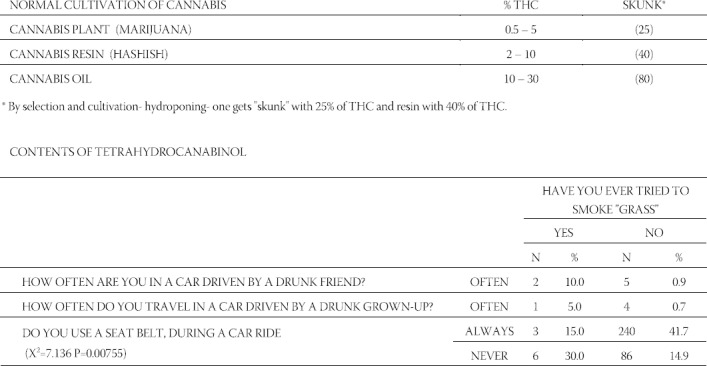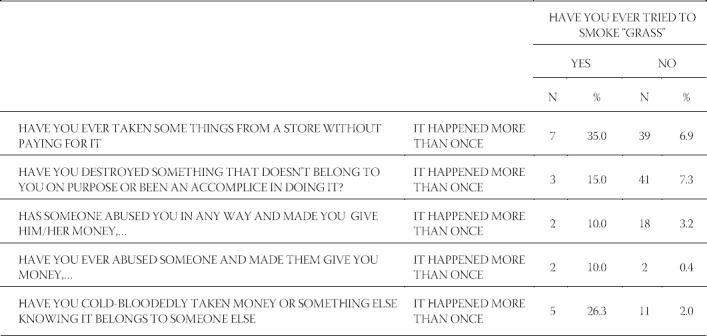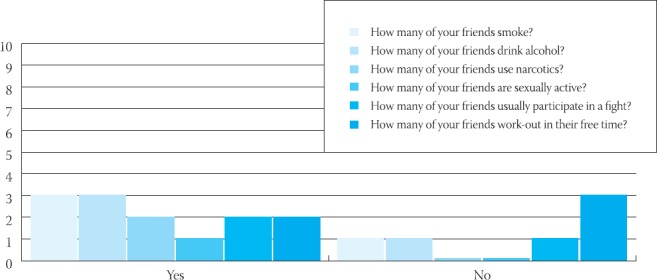Abstract
It is a well known fact that drug abuse is most common in early adolescence. The most popular substances among youth are cannabis products (made from Cannabis sativa L., Cannaba-ceae). The majority of heroin and cocaine addicts have started with marijuana. The aim of this study is to show some psycho-social characteristics of adolescents who abuse cannabis. Research conducted during the year 2001 was epidemiological and prospective. The study group included 600 adolescents of equal gender and age distribution. Q 2000 questionnaire was used, as a comprehensive tool for all aspects of adolescent life. The results show strong peer impact on one’s behavior. Youth who use cannabis had 2-3 friends of the same behavior, compared to others who had none. We found positive correlation between life stressful events and cannabis abuse. We also noticed tendency to delinquent behavior related to cannabis abuse (35%).
Keywords: adolescence, cannabis, abuse, psychosocial, peer, delinquency
INTRODUCTION
For approximately 4.500 years, Cannabis sativa L. plant is grown all over the world for different purposes (production of fabric, oil, drugs). The kinds of cannabis, which are used as drugs prosper in tropical areas; and, the ones from which oil and fabric are produced prosper in subtropical areas and mild climates. Since very old times, cannabis has been used for many purposes during various rituals (similar to the use of coffee, tea or tobacco) in numerous tribal communities native to North Africa, Middle East, territories that are within the state borders of present Pakistan, India, Nepal, Afghanistan. According to the UN Convention definition, the following terms are used for cannabis:
-Cannabis plant-any plant from genus Cannabis
-Cannabis- represents the flowering tops with intact resin
-Cannabis resin-raw or purified resin separated from the cannabis plant
-Cannabis oil-concentrate extracted from cannabis resin or cannabis
-Cannabis - similar to tobacco, green or brown leaves and the flowering tops of the cannabis plant.
COMMON NAMES: marijuana grass
hemp - It is commonly used by smoking (0.5-1 g)
ganja
bongo
Cannabis resin-black or dark brown resin-like matter processed from cannabis plant. It exists in the following forms: fine powder, tiles, unleavened bread. It can be smoked alone or mixed with tobacco (1/10 g) or used in food as infusion, cookies. Some common names in narco-slang are: hashish, kif, shit. Cannabis oil can be extracted from the resin as tar, red or dark green viscous liquid. Very potent, 1-2 drops are placed on a piece of paper or tobacco. Names: honey oil, red oil. Through detailed chemical analysis over 427 substances were found in cannabis. Some of those are psychoactive substances. It was determined that cannabis contains approximately 60 molecules of canabinoid type. The best known canabinoids are: tetrahydrocanabinol (THC), canabinol, canabidiol, canabigerol, canabicromen, Cannabis acid. Familiar kind of cannabis is “Sinsemila” which produces no seeds. Such plant is produced by removing “male flowers” during their blooming, so that insemination cannot occur and the plant is persuaded to bloom further and thus produce greater amount of resin on the flowers. Sinsemila contains enormous amount of a psychoactive canabinoid - THC. Unique way of growing cannabis is known in the countries with continental or colder climate. No matter what the outside conditions are, cannabis is grown in the closed spaces (usually a basement), which are specifically arranged for this purpose. Beside the necessary fertile soil, plastic sheets need to be installed on the walls and water and light constantly provided. Favorable conditions (fertile soil, a lot of humidity, heat and all-day light) result in very successful cultivation of cannabis. This way to grow it is called “hydropon-ing”. Cannabis produced in this way is called “skunk” Otherwise, for “harvesting” - removing the resin from the flowering tops, various techniques are used, for example, rubbing with the hands, shaking against the wall, walking through a plantation in a special suit. “Sinsemila” - contains 5-14% of the THC. Pharmacological effects mainly depend on the experience but also on the expectations of a user. The following experiences were described by the largest number of the interviewed cannabis users - good mood “high”, euphoria, a nice relaxed state, an increased activity of sensors (receptors): vision, smell, taste, hearing. Substance abusers who used cannabis for a short period usually experience increased appetite, increased heart rate, eye redness, while the drug is still in effect, the mental and physical abilities are reduced. Increase in dosage causes distortion and confusion of vision, hearing and other receptors. Large doses cause hallucinations. Substance abusers who have used cannabis for a prolonged time usually experience loss of drive and interest in activity. One may develop moderate tolerance (psychological dependence is possible), Cannabis smoke contains 50% more tar than the worse cigarettes so there is also a risk of lung cancer, chronic bronchitis and other respiratory system diseases. Besides certain ritual values, people attribute cannabis some medicinal value, that is, ability to heal certain diseases. Modern medicine did not find any justifiable medical reason for use of the canabinoids in treatment of diseases. Therefore, cannabis is placed on the List I in accordance with the UN Convention on narcotic drugs, 1961. The most recent research show that the synthetic LHC—dronabi-nol (Marinoi) may be effective in treatment of glaucoma, decrease muscle contractions in case of epilepsy, or as analgetic in patients on chemotherapy (used as antiemetica—a substance which decreases vomiting) and perhaps for appetite stimulation in patients with AIDS. WHO recommendation regarding the medical use: Although there has been a significant development during the past few years, there is still a need for scientific research, especially in the area of clinical and epide-miological research about the influence of cannabis on human health and pharmacology, but also further research in the area of using cannabis as medicament (1). Although it has not been found that cannabis causes physical addiction but only a moderate form of psychological addiction, scientific studies show that many abusers of cannabis have continued-deepened their experience— with a “stronger” experience by moving onto heroin. Problems connected with abuse of psychoactive substances in Bosnia and Herzegovina was registered for the first time in early eighties of the twentieth century. According to the most recent data, the most commonly abused substances are cannabis, anti Parkinson’s disease drugs, glues and solvents, heroin, ecstasy, sedatives and hypnotizers, alcohol, tobacco, and very rarely hai-lucinogens, cocaine and others. Although drug abuse occurs at any stage of life, its occurrence is the most significant in adolescence. Thus, this paper focuses on that population with an aim to analyze some aspects of different behaviors of youth who use cannabis.
MATERIAL AND METHODS
THE KIND OF RESEARCH
The conducted study is of an epidemiological and prospective type.
STUDY GROUP
This research includes total of 600 adolescents, 200 in Tuzla Canton (100 primary school pupils and 100 high school students) and 400 in Sarajevo Canton (200 primary school pupils and 200 high school students). Average age of subjects was 12-17 years with equal gender representation as well as equal representation according to living conditions (rural-urban).
RESEARCH INSTRUMENTS
In order to obtain the needed information, we used Q 2000 test, an instrument which was created during the period 1990-1991. This test is scientifically valid and widely accepted in the world, and it is adequate for the topic under consideration. It contains a wide range of questions about the relevant factors, which may influence use and abuse of drugs from all aspects of adolescent life; health culture, life style etc. In all schools the conducted survey was anonymous and voluntary. The research preparations as well as the survey were conducted simultaneously in Sarajevo and Tuzla cantons during the year 2001.
RESULTS
The research results were subjected to standard statistical analysis using software EPI-INFO. Data are presented in table and graph formats (2). Relevant data gathered from our subjects in connection with their age and sex are presented in the following two tables and one graph, followed by the comments. Risky behavior is more often found in the young people who are susceptible to use of narcotics: in a car driven by a drunk friend 10.0%: drunk grown-up 5.0%, seat belt always used by 15.0%; and in a group which does not use narcotics against the same parameters: 0.9%, 0.7% and seat belt is always used by 41.7%, which is shown in Table 1. Data presented by the graph show that group influence on an individual is significant in relation to the abuse of harmful and dangerous substances. Table 2. present that users of narcotics have a higher degree of inclination towards delinquent behavior. The value of X2 shows significant difference between the two groups of participants when delinquent behavior of youngsters is concerned.
TABLE 1.
Risk behavior of young people who use cannabis

TABLE 1.
Risk behavior of young people who use cannabis

GRAPH 2.

Intensity of radiofàrmaceutical uptake
DISCUSSION
Considering a significance of the adolescent period in one’s lifetime and serious disorders that can octive substances compared to their peers who do not. For example, young people who consume cannabis would more likely ride in a car which is driven by a drunk friend 10.0 70: drunk grown-up 5.0 70, seat belt is always used by 15.0 70; and in a group that does not use nar-cotíes against the same parameters; 0.9 70,0.7 70, and seat belt is always used by 41.7 70, which is shown in Table 1. Literature is abundant in data which suggest similar variables and results. The conclusion is that persons in that age group manifest multiple risk behavior more often (3).
Our study considered peer influence as well. It was found that youngsters who abuse cannabis, alcohol and other narcotics have, on average, two or three friends with the same habits, compared to the other group of young people who do not have any or have just one such friend. A peer influence proved to be very significant in abuse of harmful and dangerous substances. This observation is in agreement with the works of authors from around the world and many studies, which have shown that the characteristics of a group an adolescent spends time with and its attitude toward drug abuse are very relevant. Results from the literature illustrate the same conclusions: risky behavior of youngsters in comparison with the use of psychoactive substances could be a prediction for future behavior (4,5,6,7,8). A focus of our research was also delinquent, destructive behavior of young people. It is important to stress that smoking, alcohol and drug consumption are in a direct, high correlation with destructive behavior of youngsters. Some authors have shown that easier access to weapons, drugs and alcohol increases the risk of delinquent behavior (9,10). Young people who participate in fights assert in 20% cases that they will continue with such behavior (8). At the end of this fragmented elaboration, we can come to a general conclusion that our research is, for the most part, in agreement with the studies of some world authors, what can be seen through this discussion.
CONCLUSIONS
In the end we can conclude that during our research we have registered risk factors for abuse of the psychoactive substances by the young people. The most important ones are:
Young people who use cannabis show high degree of inclination towards different kinds of risky behavior (riding with a drunk friend or drunk grown-up, non-usage of safety belt etc.).
There is a great probability that an individual will take on the characteristics of a group (he/she will start to consume one or more of the harmful substances if this is present in his/her immediate surroundings).
The consumers of cannabis are more inclined towards delinquency (theft in 35.0 70).
REFERENCES
- 1.Sinanovié O, Ovisnost O Drogama. Tuzla:Medicinski fakultet. Behrambegova medresa. 2001;9(42):131–140. [Google Scholar]
- 2.Dean A.G, Dean I.A, Burton AH, Dicker R.C. Epi Info. A Word Processing, Database, and Statistics System for Epydemiology on Microcomputers (computer program) Atlanta, Georgia, USA and Geneva, Switzerland: Centres for Disease Control and World Health Organization; 1990. [Google Scholar]
- 3.Cobb B, Cairns B, Miles M, Cairns R.A. longitudinal study of the role of sociodemographic factors and childhood aggression on adolescent injury and “Close Calls”. J Adolesc Health. 1999;17:381–388. doi: 10.1016/1054-139X(95)00059-2. [DOI] [PubMed] [Google Scholar]
- 4.Baumrid D.A. Developmental perspective on adolescent risk-taking in contemporary America. Vol. 37. San Francisco: Jossey-Bass; 2000. [DOI] [PubMed] [Google Scholar]
- 5.Dignan M.B, Steckler Α, Block G.D. Prevalence of health-risk behavior among seventh grade students in Carolina. South. Med. I. 2000;79(3):295–298. doi: 10.1097/00007611-198603000-00009. [DOI] [PubMed] [Google Scholar]
- 6.Berg-Kelly K. Normative developmental behavior with implications for health and health promotion among adolescents:A Swedish cross-sectional survey. Acta Paedriatica. 1999;84:278–288. doi: 10.1111/j.1651-2227.1995.tb13629.x. [DOI] [PubMed] [Google Scholar]
- 7.Berg-Kelly K, Kullander K. Do adolescents'own intentions regarding healthy behaviors affect outcome? A Two Years Prospective Study. Acta Paedriatica. 1999;88:983–989. [PubMed] [Google Scholar]
- 8.Berg-Kelly K, Kullander K. Gender Differences in early adolescence in factors related to outcome of healthy behaviors two years later. Acta Paedriatica. 1999;88:1125–1130. doi: 10.1080/08035259950168207. [DOI] [PubMed] [Google Scholar]
- 9.Grufman M, Carlsten C, Krabbe M, Berg-Kelly K. Health and health behaviors among Swedish adolescents during a period of social change. Acta Paedriatica. 1999;88:1380–1384. doi: 10.1080/080352599750030121. [DOI] [PubMed] [Google Scholar]
- 10.Harold I, Kaplan M, Benjamin J, Sadock MD. Comprehensivetextbook of psychiatry/ VII. 7th ed. Chapter 13. Vol. 2. Substance-related disorders, 2000:Williams and Wilkins Baltimore; pp. 755–872. [Google Scholar]


